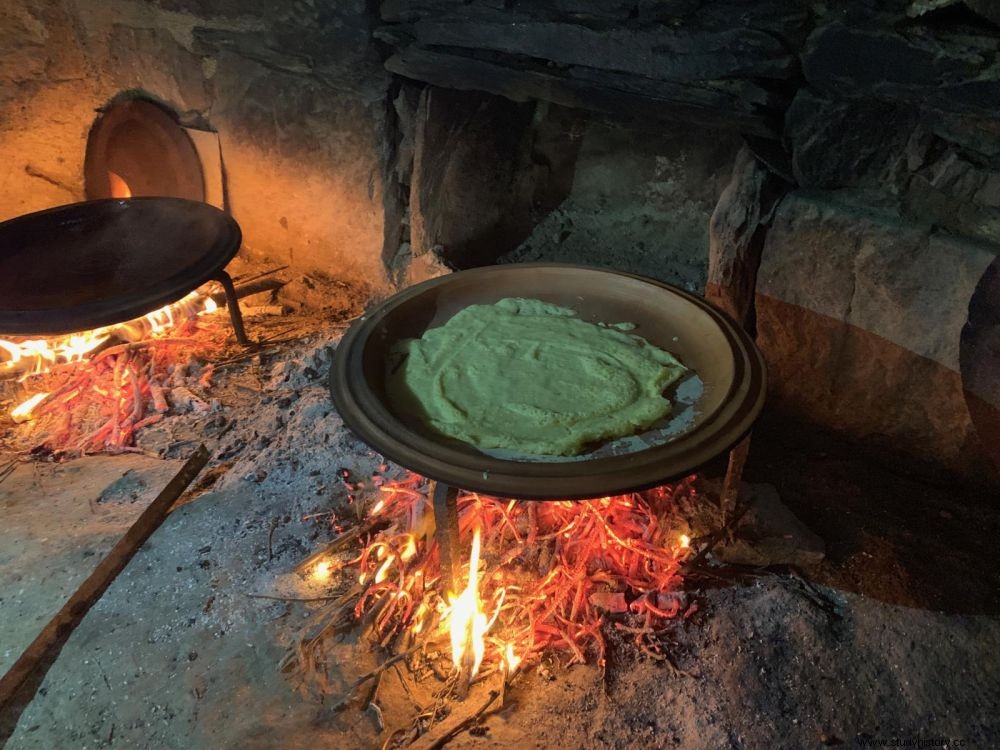Medieval galettières have been found on the site of the former abbey of Landévennec, in Finistère. Physico-chemical and experimental analyzes have determined that these were used to cook pancakes as early as the 13th century.

The galettières were reconstructed and tested before being exhibited in the museum of the former abbey of Landévennec.
At the end of research spread over more than five years, the scientists of the museum of the former abbey of Landévennec have had a clear conclusion:the monks of the abbey were already cooking Breton galettes in the Middle Ages.
Slabs found in the pits of the abbey
The origin of this study goes back to a discovery:in the pits of the old abbey of Finistère were found pieces of medieval ceramics of a very characteristic shape... These galettières, circular dishes in terracotta one centimeter thick thickness and from twenty-five to forty centimeters in diameter, are found nowhere else than in the Breton region.

The found object was archaeologically complete, i.e. sufficiently well preserved to be reconstructed in its original form. Credits:Archaeologists:A. Bardel and R. Pérennec, coll. Museum of the former abbey of Landévennec
"These containers are recognizable both by their shape, but also by their material, the creamy ceramic, rich in talc to reinforce their resistance to high temperature cooking", explains to Sciences et Avenir Guénolé Ridoux, in charge of exhibitions at the museum of the former Landévennec abbey. But how can you be sure that these dishes, dating from the 13th and 14th centuries, were indeed used to cook the famous Breton galette?
Traces of butter and other dairy products
Chemical analyzes - chromatography and mass spectrography - were first carried out on the two pans selected for the study. The scientists were then able to determine the presence of short-chain fatty acids, chemical markers of dairy products. The analyzes also revealed traces of phytanic acids and cholesterol as well as products of the breakdown of triglycerides at high temperatures, witnesses to the use of butter for cooking.

The results of the physico-chemical analysis have been summarized in an infographic. Credit:David Yven
More interestingly, the odd ketones detected in the ceramic suggest fat cooking at very high temperatures, between 240 and 270°C. "These data are perfectly compatible with the cooking of pancakes today, at over 220°C!" , emphasizes Guénolé Ridoux.
In search of the perfect cooking
In order to verify these analytical results, the scientists got down to experimental archaeology, a field of archeology aimed at tracing the gestures and techniques passed through experimentation. Six pancakes were thus reconstituted to be tested under different cooking conditions. With butter, lard or even on the hearth, each container was subjected to a separate protocol. The objective:to compare the traces left by these different uses with the original pancakes.

The six pans were tested with different cooking temperatures and lubrications. Credits:Museum of the former abbey of Landévennec
In total, the team was able to carry out a dozen experiments. If the analysis of the samples and the comparison with the medieval galettières are still in progress, the archaeologists can already affirm certain elements:the food cooked in the Breton container was a liquid paste, containing dairy products and heated to a temperature of more 200°C… No doubt, these are pancakes!
"When the pancake becomes Breton"
This investigation around medieval galettières is actually included in a larger investigation around the origin of the crepe. This gave rise to the exhibition "When the pancake becomes Breton", open since June 2020 at the museum of the former abbey of Landévennec. On the program:games, manipulations and videos to learn more about the origin, traditions and controversies surrounding this mythical dish.
Video of the exhibition "When the pancake becomes Breton" at the museum of the former abbey of Landévennec. Directed by:Marc Beugnot, Her-Bak Media
Exhibition When the pancake becomes Breton at the museum of the former abbey of Landévennec. From June 21 to November 1, 2020, daily from 10:30 a.m. to 6 p.m. Price:6 euros (reduced:5 euros).
